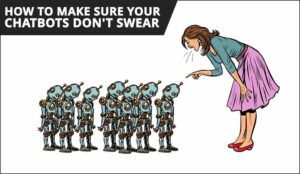Athena Steimberg of Odigo argues that chatbots have become a channel in their own right, but we need to get the right support behind them.
A chatbot is a conversational program present on digital channels, such as websites, instant messengers, mobile applications, etc.
Supported by the internet and mass marketing giants who are doing everything they can to simplify developers’ lives, the conversational agent has come back to the forefront with the advent of a chatbot for Facebook Messenger.
Since then, the number of interactions with it have been increasing!
The concept of chat is not new. Without going back to the 60s and Eliza, the very first chatbot, the early chatbots first appeared as avatars most often in FAQs impersonating virtual agents.
Disappointed by their ability to respond, some businesses turned to live chat with real agents who sometimes suggested that they were virtual agents!
Despite the confusion they have caused, these devices have prepared users for chat. The difference is that with advances in automatic natural language processing (NLP) and in the age of automation, a well-designed chatbot is now able to have a real conversation!
The Phone Channel, Still the Preferred Mode of Communication
It should be remembered that cases of self-service use have existed for several decades on the telephone channel – think here of the banks’ interactive voice server (IVR).
Nevertheless, they have gradually been neglected for web applications, available 24 hours a day, for simple and/or precise tasks.
However, according to a recent Zendesk study, the phone channel remains very popular, regardless of the age of the consumer. Accumulating 68% of interactions, it is by far the first channel used to contact customer services.
How can this popularity be explained? Beyond the historical attachment, it should be stressed that in terms of customer relations, the telephone channel makes it possible to give a more human dimension to interactions. It will always be preferred for critical requests, combining both urgency and emotions (stress, anger, etc.).
Certainly, a chatbot is able to respond precisely, immediately, and at any time. Nevertheless, in this type of situation, a client will prefer a real agent to a virtual agent, even one with a feeling analysis function. That’s why a chatbot should easily allow you to connect with an agent.
The idea that AI will replace humans remains a distant promise. More than 80% of customers who reported having had an interaction with a bot admit to having interacted with a human later.
On the other hand, while almost three-quarters of clients say they prefer to interact with a human agent, about half say AI is useful for simple problems and 24-hour support.
Beyond the human dimension, certain interactions deserve humane treatment because:
- The risk of attrition is too high
- The business potential is too great not to secure it with its best agents
- Or the request rarely occurs and cannot be automated
That is where the chatbot can fully play one of its key roles: qualify the contact interaction. The interaction that will be presented to the agent needs to go through a fine and optimal qualification to find the most relevant competence to deal with it.
Who is the user? Are they already a customer? What is the reason for their call? When were their previous interactions with the brand and on what topics? All this information allows the agent to process the request immediately and efficiently.
Best of all, the user does not have to identify himself or herself or explain the reason for their call again, which irritates 22% of consumers, according to Zendesk.
Moreover, the reactivity offered by chatbots is a source of relief for the user. Especially if they receive a notification by SMS that the request has been taken into account, and are kept informed throughout the process.
The Chatbot: A “Friendly” Tool
Appreciated by instant messaging enthusiasts, chatbot has gradually spread over digital channels.
The challenge for brands lies in the value that the chatbot will bring in addition to other devices and channels: immediacy, unpublished information, and ease of dealing with personal and sensitive subjects.
Thus, a customer having unfortunately lost his credit card will call the contact centre to let them know, as it seems more reliable and faster.
Others will give even more credit to the machine and its immediate consideration, preferring to use an application or a chatbot.
How can your contact centre take advantage of a chatbot available on different interfaces to improve the customer experience?
By capitalizing on this service approach and integrating it into a global user experience that takes into account an omnichannel customer journey, where:
- Channels will be considered for their complementarity or subsidiarity, and a user journey started at one contact point may very well end at another. Strategic and/or technical choices will determine which information to deliver, on which channels, and how.
- Ergonomics will be key: mixing chat and choice buttons, video content, etc. The chatbot application must be user friendly to keep the user up to date.
- The conversational aspect will require a good understanding of intentions through the natural language understanding (NLU) model and continuous learning with machine learning (ML).
Support, a Key Element
The need to be supported can be all the more acute if it is necessary to consider and make converge different applications driven by different entities.
Small or large, a company whose customer service department manages numerous flows on a daily basis will aim to offer the most fluid experience possible.
There is nothing more efficient than an end-to-end solution that ensures a seamless customer experience across channels while improving the agent experience.
Author: Robyn Coppell
Published On: 5th Sep 2019 - Last modified: 27th Jun 2022
Read more about - Guest Blogs, Odigo















